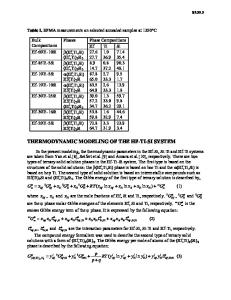An experimental study and thermodynamic calculations of phase equilibria in the Fe-Mo-C-N system
- PDF / 4,376,609 Bytes
- 12 Pages / 597.28 x 777.28 pts Page_size
- 39 Downloads / 346 Views
I.
INTRODUCTION
FOR the development of alloys, thermodynamic calculations of phase equilibria can be of great use. To perform reliable calculations, it is important to carefully analyze all available types of thermodynamic information for the system of interest, including information in the lower-order systems, using thermodynamic models. The present study was performed to build the basis for thermodynamic calculations in sintered steel, by analyzing the system Fe-MoC-N. Most of the lower-order systems have previously been analyzed, and a set of consistent descriptions was selected for the present work (Fe-Mo,tl] Fe-C,E2] Fe-N and Mo-N, Ial Mo-C,[ 41 Fe-Mo-C,t5j Fe-Mo-N, E61and Fe-C-NI7]). The MoC-N has not previously been evaluated. Ettmayed8~ established a tentative phase diagram for the Mo-C-N system at 1373 K by investigating nitrided Mo-C alloys. The data by Ettmayer were analyzed in the present work using thermodynamic models, as described in Section II. The thermodynamic descriptions of the lower-order systems mentioned previously can be combined, because consistent models and descriptions of the pure elements were used. By combining the descriptions of the lower-order systems, reliable extrapolations into higher-order systems can often be made; it is, however, important to compare such calculations with experimental information. For the analysis of the quarternary Fe-Mo-C-N system, it was found that new experimental information was needed. Thermodynamic calculations were first performed to select the experimental conditions, as described in Section II. The experiments that were performed are described in Section III, and the analysis based on these new experimental results is described in Section IV. II.
THERMODYNAMIC CALCULATIONS
A. Thermodynamic Models A thermodynamic model for phases with several sublattices[9] is used to describe the Gibbs energy of the individual
KARIN FRISK, Senior Research Scientist, is with the Swedish Institute for Metals Research, Drottning Kristinas, S-11428 Stockholm, Sweden. BJORN UHRENIUS, formerly Head of Department wxth the Swedish Institute for Metals Research, is Vice President, Research and Development, AB Sandvik Hard Materials, S-12680 Stockholm, Sweden. Manuscript submitted September 11, 1995. METALLURGICAL AND MATERIALS TRANSACTIONS A
phases. For one formula unit, (Fe, Mo)o(C, N, Va)c of a phase, where Va represents vacant interstitial sites, the model yields the following expression for the Gibbs energy: Gm= ~.~ E yMy,~ M 1
(]~M YM In YM)
+ aRT
+ cRT (]~y, In Yt) + eG,. + Grog [1] I
where eGm denotes the excess Gibbs energy and is given by
eGm = EM E1 J>l E YMY,yjLMu + ]~ ~,~ ~yMYNyILM.N, [2] M N>M l where M and N represent elements on the first sublattice (Fe, Mo) and I and J elements on the second sublattice (C, N, Va). The site fraction of the element I is denoted by yp The Gibbs energy of a hypothetical nonmagnetic state of Mff~ is denoted by ~ M1" ~ va denotes the Gibbs energy of the hypothetical nonmagnetic state of the element M. The contribution du
Data Loading...











